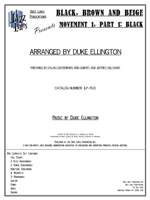BLACK, BROWN, AND BEIGE - MOVEMENT 1, PART 1: WORK SONG [DOWNLOAD]
Arranged by Duke Ellington, Prepared by Dylan Canterbury, Rob DuBoff, and Jeffrey Sultanof

Cat #: JLP-7357-DL
$75.00This product is available for immediate download after purchase.
Questions?
Please call +1-518-587-1102 or email us.
Edition: Jazz Big Band Arrangement
Description: Swing - Advanced
Publisher: Jazz Lines Publications
Although there are no vocals, there is an unquestionably operatic atmosphere to "Work Song." Duke Ellington's lengthy jazz quasi-oratorio can be roughly broken into three different musical motifs, each coming back multiple times throughout the piece both individually and intertwining with one another.
The first of these motifs is the now iconic introductory fanfare at measure 5, which largely serves as the "chorus" of the movement. Thumping double-stopped bass and pounding tom-toms provide the earth-shattering rhythmic foundation underneath a triumphant rhythmic riff that passes back and forth between the saxophones and brass. This section, regardless of location or dynamic level, needs to possess an authoritative presence in order to maintain a consistent emotional impact. Examples of these "choruses" occur at measures 25, 67, 117, and 189.
The second motif appears first at measure 11, taking the form of a saxophone section soli. This can effectively be considered the "recitative" portion of the "oratorio," as these sections often serve as musical bridges between the "arias" of the individual instrumental soloists. They are often accompanied with a slight uptick in tempo from the "choruses," as well as a general lighter overall feel. Other examples of these "recitatives" occur at measures 39, 145, and 158 (albeit in the trumpets on this occasion.
Last but not least is the motif of the individual soloists, performing their "arias" at various points across the duration of the movement. To add to the comparison to opera, the four primary voice ranges are represented by four separate instruments. First is the "bass-baritone" of Harry Carney's baritone saxophone at measure 72. Following in succession from here is Shorty Baker's trumpet (the "soprano") at measure 123, "Tricky" Sam Nanton's trombone (the "tenor") at measure 145, and finally Johnny Hodges' alto saxophone (the "alto") at measure 214.
Some general performance notes:







![MOOCHE, THE [DOWNLOAD]](https://www.ejazzlines.com/wp-images/product/thumbnail/28046-s.jpg)

